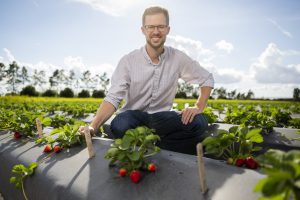Strawberry consumers love the fruit’s sweet flavor, and University of Florida scientists are trying to meet that desire, while also helping growers produce high yields.
But genes and volatile compounds that control flavor are difficult to pinpoint, said Mark Porter, a Ph.D. student in the Plant Breeding Program at the UF/IFAS College of Agricultural and Life Sciences.

In a newly published paper, Porter leads three authors who outline the past, present and potential future of breeding flavor into strawberries.
For years, scientists tried to find just the right genes for flavor, but they lacked a genetic map. Researchers found the GPS in 2019, when the first cultivated strawberry genome was published, said Porter.
“Think of it like you want to get to Seattle from Florida without a map or road signs,” he said. “With the construction of the first strawberry genome and the reduced cost of obtaining genetic information from our strawberries, we can now find the location in the genome that’s responsible for production of aroma compounds. That’s akin to scientists who study humans finding the genes that control eye color.”
Scientists also know that simply breeding for more sugar in berries will result in lower yields for growers.
“Now, we have the tools to find the right genetic combination for flavor and yield in strawberries,” Porter said.
UF/IFAS is adding these tools to its arsenal to breed strawberries for many traits, including flavor, yield and disease- and pest-resistance. For example, GCREC recently hired Kevin Wang, an assistant professor of agricultural and biological engineering, who’s using artificial intelligence to help plant breeders at the center.
Still people’s taste buds can be finnicky. Depending on who’s eating the fruit, people prefer different aromas and tastes, so it’s important to conduct taste-test panels with your demographic of interest, said Porter, who’s doing his doctoral research at the UF/IFAS Gulf Coast Research and Education Center (GCREC).
Those consumer panels – conducted at the UF main campus in Gainesville — tell scientists the strawberry varieties they prefer and why. From that data, scientists select strawberries for certain genes.
Porter’s co-authors on the paper are his faculty advisors at GCREC: UF/IFAS horticultural sciences Assistant Professor Seonghee Lee and Professor Vance Whitaker.

“In order to increase U.S. consumption of strawberries and other healthy fruits, we must continue to prioritize improving flavor in new varieties,” Whitaker said. “But we also have to keep improving yield and disease resistance for our growers. To do all these things at once, we have to work smarter and harder.”
UF/IFAS strawberry breeders are prolific. Of the 12,000 acres of Florida-grown strawberries, UF/IFAS cultivars are grown on 10,000. Varieties from the fruit are grown in 36 countries and on all continents except Antarctica.
Genetics will continue to help traditional field-breeding efforts, which will increase the odds of the next generation of strawberries being more flavorful, Porter said.
“There are over 100 aroma compounds controlled by different genes,” he said. “That means you want to combine as many genes as possible in your latest variety. It is also hard to uncover the genes controlling specific aroma compounds because the chemistry behind identifying the aroma compounds is technical and takes a long time. That contrasts to traits like fruit size, which can be easily measured many times in a season.”
###
ABOUT UF/IFAS
The mission of the University of Florida Institute of Food and Agricultural Sciences (UF/IFAS) is to develop knowledge relevant to agricultural, human and natural resources and to make that knowledge available to sustain and enhance the quality of human life. With more than a dozen research facilities, 67 county Extension offices, and award-winning students and faculty in the UF College of Agricultural and Life Sciences, UF/IFAS brings science-based solutions to the state’s agricultural and natural resources industries, and all Florida residents.
WHY FOOD IS OUR MIDDLE NAME
Feeding a hungry world takes effort. Nearly everything we do comes back to food: from growing it and getting it to consumers, to conserving natural resources and supporting agricultural efforts. Explore all the reasons why at ifas.ufl.edu/food or follow #FoodIsOurMiddleName.
 2
2
